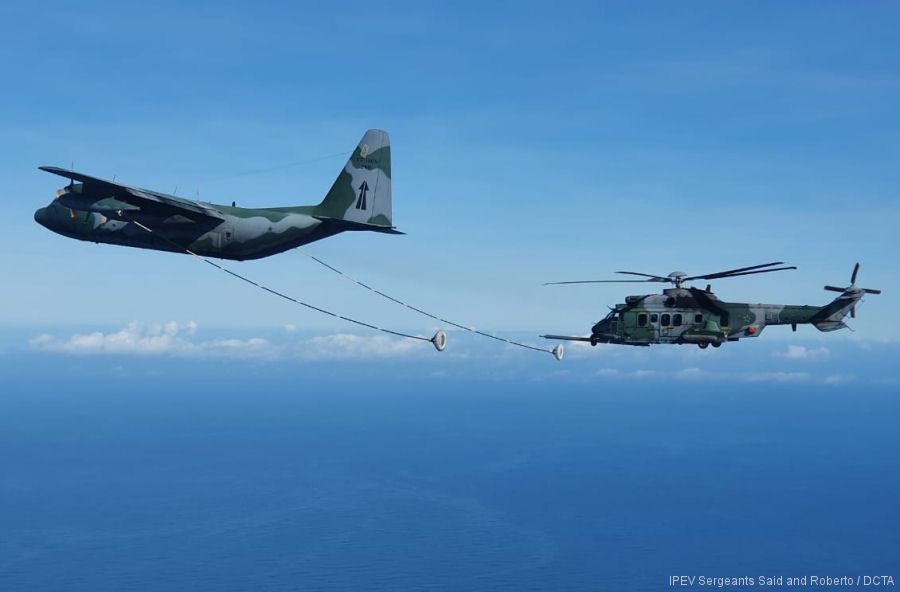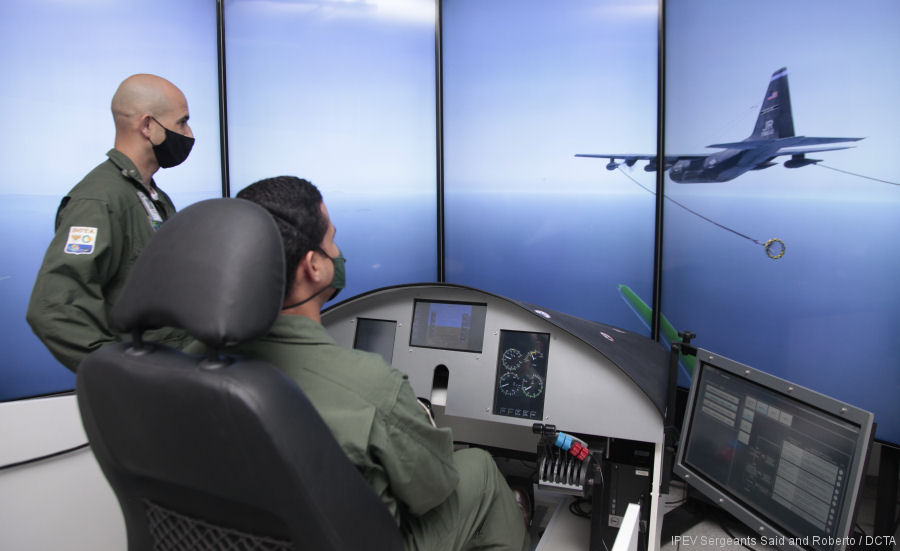
Forca Aerea Brasileira, November 09, 2020 - The Brazilian Air Force (FAB), through a technical and multidisciplinary team coordinated by the Department of Aerospace Science and Technology (DCTA), concluded, on October 30, in Rio de Janeiro (RJ), the last phase of the inflight refueling (REVO) tests campaign between the H-36 Caracal helicopter and the KC-130 Hercules aircraft.
The flights took place in a restricted area under military control, on the coast of Rio de Janeiro, where the refueling aircraft KC-130 Hercules of the Squadron Gordo ( “fat”, 1st / 1st GT) and H-36 Caracal helicopters from squadrons Falcão (1st / 8th GAV) and Puma (3rd / 8th GAV) met to perform the REVO procedure.
Operational support from Air Wing 11 as 12 and administrative support from Galeão Air Base (BAGL) and Santa Cruz Air Base (BASC) were essential for the success of the operation.
During the tests, the helicopters ( receivers ) approached the aircraft KC-130 ( tanker ), which made the transfer of fuel to the helicopters. Through its refueling hoses, more than 160 in-flight connections were made.
The current Campaign aimed to complete the tasks foreseen in the certification process, including the unprecedented steps of transferring fuel from the KC-130 to the H-36 and the simultaneous refueling of two helicopters.
In addition, the instructors of the Flight Research and Testing Institute (IPEV) carried out operational training for the pilots of the Falcão and Puma Squadrons, belonging to the Air Force Training Command (COMPREP). As a result, Brazil becomes the first country in South America with the ability to refuel helicopters in flight.
In-flight fuel transfer enhances the capabilities of the H-36 in fulfilling its Air Force actions, such as Combat SAR (CSAR), and expands its operationality, with increased autonomy to carry out rescue missions at sea, helps humanitarian aid, infiltration of troops and transportation of military personnel in strategic locations.
"It is rotary wing aviation which contributes to the mission of defending and integrating the 22 million square kilometers - Dimension 22 - under the responsibility of the FAB", emphasizes the test pilot and general coordinator of the operation, Colonel Aviator José Ricardo Silva Scarpari.
In addition to these objectives, the campaign also sought to obtain structural strength data, in order to complement the training of DCTA engineers and researchers for the future REVO campaign between the H-36 helicopter and the KC-390 Millennium aircraft, scheduled for the year 2021.
According to the operational pilot of the Puma Squadron, Captain Aviator Rafael D'Amato Guimarães, participating in the certification campaign was an enriching professional experience. “Conducting operational training flights with pilots and engineers from the Flight Research and Testing Institute (IPEV) made me know more about the technical base of these professionals and learn the 'why' of each procedure. This will be essential for the development of the helicopter REVO employment doctrine, ”he says.
Three H-36 Caracal aircraft of the operational version were used in the campaign, equipped with a refueling probe and infrared electroptic system (FLIR).One of the helicopters had sensors installed that enabled the acquisition of fundamental data to ensure the safety of the REVO procedure of the pair KC-130 and H-36.
During the flights, the most extreme conditions of speeds, altitudes, aircraft weights and operation of the fuel systems were tested. For this, it was necessary, in the planning phase, a thorough analysis as to the geometric, functional and performance compatibility between the two aircraft and their respective systems. For Lieutenant Luís Gustavo Leandro de Paula, flight test engineer for the campaign, “the objective is to deliver the Squadrons with the most comprehensive operating envelope possible, ensuring not only the safety of the procedure but also greater flexibility for the fulfillment of future missions of REVO ”, he says.
The entire coordination of the campaign was carried out by DCTA, which participates with three of its units: the Aeronautics and Space Institute (IAE), which assisted by means of a technical team in the installation of dedicated sensors and in the analysis of data from these equipment; the Institute for Promotion and Industrial Coordination (IFI), responsible for coordinating the entire aircraft certification process; and IPEV, responsible for planning, defining and executing the tests.
The campaign also included COMPREP, the General Support Command (COMGAP), the Directorate of Aeronautical and War Material (DIRMAB), the Coordinating Committee of the Combat Aircraft Program (COPAC), the Aeronautical Material Park of Galeão (PAMA -GL), the São Paulo Aeronautical Material Park (PAMA-SP), the Air Force Academy (AFA), in addition to the companies Helibrás and Airbus Helicopters.
In the first phase of the Campaign, held in 2018, ground tests were carried out, training of test pilots and obtaining the first data from flight tests with dry connection (without fuel transfer).
For the 2020 Campaign, a new test program was prepared, in which all the possibilities to be tested were studied, as well as the analysis of the risks involved and their respective mitigating actions. To this end, the IPEV pilots undertook training on the H-36, graduation training between the H-50 Esquilo and H-60 Black Hawk aircraft and graduation flight between the H-36 aircraft and the T-27 Tucano.
It is noteworthy that this is the first helicopter campaign in which a fixed wing aircraft (T-27) was used as a flirting aircraft, being necessary to develop specific graduation flight procedures between an airplane and a helicopter.
The preparation and training prior to the REVO flight took place in São José dos Campos (SP), where the operational pilots of the Squadrons carried out the training in the Flight Test Simulator of the IPEV. In this opportunity, pilots and flight test engineers were able to demonstrate, in a simulated environment, the dynamics of the refueling maneuver, the necessary cabin coordination, the emergency procedures specific to the maneuver and the piloting techniques to be employed.
The flights took place in a restricted area under military control, on the coast of Rio de Janeiro, where the refueling aircraft KC-130 Hercules of the Squadron Gordo ( “fat”, 1st / 1st GT) and H-36 Caracal helicopters from squadrons Falcão (1st / 8th GAV) and Puma (3rd / 8th GAV) met to perform the REVO procedure.
Operational support from Air Wing 11 as 12 and administrative support from Galeão Air Base (BAGL) and Santa Cruz Air Base (BASC) were essential for the success of the operation.
During the tests, the helicopters ( receivers ) approached the aircraft KC-130 ( tanker ), which made the transfer of fuel to the helicopters. Through its refueling hoses, more than 160 in-flight connections were made.
The current Campaign aimed to complete the tasks foreseen in the certification process, including the unprecedented steps of transferring fuel from the KC-130 to the H-36 and the simultaneous refueling of two helicopters.
In addition, the instructors of the Flight Research and Testing Institute (IPEV) carried out operational training for the pilots of the Falcão and Puma Squadrons, belonging to the Air Force Training Command (COMPREP). As a result, Brazil becomes the first country in South America with the ability to refuel helicopters in flight.
In-flight fuel transfer enhances the capabilities of the H-36 in fulfilling its Air Force actions, such as Combat SAR (CSAR), and expands its operationality, with increased autonomy to carry out rescue missions at sea, helps humanitarian aid, infiltration of troops and transportation of military personnel in strategic locations.
"It is rotary wing aviation which contributes to the mission of defending and integrating the 22 million square kilometers - Dimension 22 - under the responsibility of the FAB", emphasizes the test pilot and general coordinator of the operation, Colonel Aviator José Ricardo Silva Scarpari.
In addition to these objectives, the campaign also sought to obtain structural strength data, in order to complement the training of DCTA engineers and researchers for the future REVO campaign between the H-36 helicopter and the KC-390 Millennium aircraft, scheduled for the year 2021.
According to the operational pilot of the Puma Squadron, Captain Aviator Rafael D'Amato Guimarães, participating in the certification campaign was an enriching professional experience. “Conducting operational training flights with pilots and engineers from the Flight Research and Testing Institute (IPEV) made me know more about the technical base of these professionals and learn the 'why' of each procedure. This will be essential for the development of the helicopter REVO employment doctrine, ”he says.
Three H-36 Caracal aircraft of the operational version were used in the campaign, equipped with a refueling probe and infrared electroptic system (FLIR).One of the helicopters had sensors installed that enabled the acquisition of fundamental data to ensure the safety of the REVO procedure of the pair KC-130 and H-36.
During the flights, the most extreme conditions of speeds, altitudes, aircraft weights and operation of the fuel systems were tested. For this, it was necessary, in the planning phase, a thorough analysis as to the geometric, functional and performance compatibility between the two aircraft and their respective systems. For Lieutenant Luís Gustavo Leandro de Paula, flight test engineer for the campaign, “the objective is to deliver the Squadrons with the most comprehensive operating envelope possible, ensuring not only the safety of the procedure but also greater flexibility for the fulfillment of future missions of REVO ”, he says.
The entire coordination of the campaign was carried out by DCTA, which participates with three of its units: the Aeronautics and Space Institute (IAE), which assisted by means of a technical team in the installation of dedicated sensors and in the analysis of data from these equipment; the Institute for Promotion and Industrial Coordination (IFI), responsible for coordinating the entire aircraft certification process; and IPEV, responsible for planning, defining and executing the tests.
The campaign also included COMPREP, the General Support Command (COMGAP), the Directorate of Aeronautical and War Material (DIRMAB), the Coordinating Committee of the Combat Aircraft Program (COPAC), the Aeronautical Material Park of Galeão (PAMA -GL), the São Paulo Aeronautical Material Park (PAMA-SP), the Air Force Academy (AFA), in addition to the companies Helibrás and Airbus Helicopters.
In the first phase of the Campaign, held in 2018, ground tests were carried out, training of test pilots and obtaining the first data from flight tests with dry connection (without fuel transfer).
For the 2020 Campaign, a new test program was prepared, in which all the possibilities to be tested were studied, as well as the analysis of the risks involved and their respective mitigating actions. To this end, the IPEV pilots undertook training on the H-36, graduation training between the H-50 Esquilo and H-60 Black Hawk aircraft and graduation flight between the H-36 aircraft and the T-27 Tucano.
It is noteworthy that this is the first helicopter campaign in which a fixed wing aircraft (T-27) was used as a flirting aircraft, being necessary to develop specific graduation flight procedures between an airplane and a helicopter.
The preparation and training prior to the REVO flight took place in São José dos Campos (SP), where the operational pilots of the Squadrons carried out the training in the Flight Test Simulator of the IPEV. In this opportunity, pilots and flight test engineers were able to demonstrate, in a simulated environment, the dynamics of the refueling maneuver, the necessary cabin coordination, the emergency procedures specific to the maneuver and the piloting techniques to be employed.

See also |
EC725 Caracal in
Caracal Helicopter Aerial Refueling in Brazil




